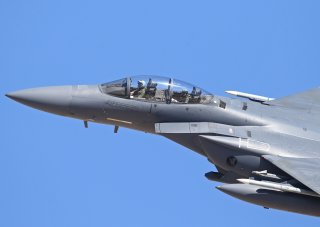Fact: The World’s Best F-15s Don't Serve in the U.S. Air Force
The QEAF will be acquiring 36 of the new F-15QA fighters, which will be delivered beginning next year in a contract worth $6.2 billion.
Here's What You Need To Remember: The F-15 Qatar Advanced (F-15QA) is the latest upgrade to a time-tested platform and it incorporates 21st-century technology.
The United States Air Force is currently eyeing a fighter currently being developed by the Qatar Emiri Air Force (QEAF), but yet it is one that it already knows quite well—it is the F-15, a fourth-generation multi-role fighter that first entered service in 1976.
Given that the Air Force has the F-22 and F-35; one might question why it would be interested in a fighter that was developed during the Vietnam War and which entered service when Gerald Ford was President. The F-15 Qatar Advanced (F-15QA) is the latest upgrade to a time-tested platform and it incorporates 21st-century technology.
The Boeing-produced aircraft completed its first flight last month at Lambert International Airport in St. Louis, where it demonstrated unmatched maneuverability and speed. This included a nearly vertical “Viking takeoff.”
“This successful first flight is an important step in providing the QEAF an aircraft with best-in-class range and payload,” said Prat Kumar, Boeing vice president and F-15 program manager. “The advanced F-15QA not only offers game-changing capabilities but is also built using advanced manufacturing processes which make the jet more efficient to manufacture. In the field, the F-15 costs half the cost per flight hour of similar fighter aircraft and delivers far more payload at far greater ranges. That’s success for the warfighter.”
The QEAF will be acquiring 36 of the new F-15QA fighters, which will be delivered beginning next year in a contract worth $6.2 billion. Apparently, the U.S. Department of Defense (DoD) and U.S. Air Force liked what they saw in this upgrade as Boeing will build a domestic variant of the advanced fighter as the F-15EX, which became a program of record last year. Future plans now call for as many as 144 aircraft to be built.
The Air Force last purchased its F-15E jets back in 2001, but Boeing stuck with the fighter and continued to add new technology and upgrade it for foreign clients including Israel, South Korea, Saudi Arabia and Qatar. The aerospace giant then pitched this new version not to replace the F-35 but rather to operate alongside it. While the F-15EX lacks the stealth capability of the F-22 and F-35, being able to fly unseen by the enemy isn’t always necessary.
What it can do is carry a larger number of missiles, and thus could be used as a protector for the less armed aircraft. It can also fly faster and higher, and could be ideal for missions that don’t need the F-35s advanced stealth capabilities. Given the costs of the F-35, the new and truly improved F-15EX could be a way for the Air Force to get a lot more bang for the buck. The Air Force expects to keep a well-rounded mix of fourth and fifth-generation aircraft in its fleet at least thought the 2030s, and this new aircraft could certainly be seen to be a good addition while replacing the aging F-15C models.
Peter Suciu is a Michigan-based writer who has contributed to more than four dozen magazines, newspapers and websites. He is the author of several books on military headgear including A Gallery of Military Headdress, which is available on Amazon.com.
This article first appeared in May 2020 and is being republished due to reader interest.
Image: Reuters

